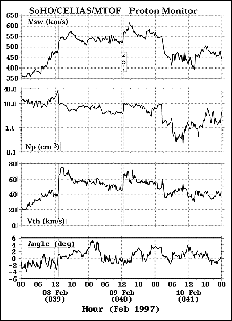|
corona consists consists of faint of faint plumes plumes aligned aligned along the along the open magnetic field lines open magnetic field lines extending from extending from the the polar coronal polar coronal hole. hole. UVCS UVCS

measurements of coronal of coronal hole outflows hole outflows show speeds show speeds as as high as high as 200 kms - 1 200 kms - 1 at at 2 RSun. 2 RSun. Time sequences Time sequences of LASCO images of LASCO images show show

individual features in plumes with speeds of 350-500 kms - 1 compared to 100-150 km s compared to 100-150 km s - 1 at the same height in coronal streamers. - 1 at the same height in coronal streamers.

SOHO is now poised to exploit these breakthrough observations. now poised to exploit these breakthrough observations. As As the mission continues, combining LASCO observations the mission continues, combining LASCO observations

with those those of of MDI, MDI, EIT, EIT, CDS, CDS, SUMER, SUMER, and and UVCS UVCS should should make make it it possible possible to to learn learn in in detail detail what what maintains maintains the the coronal coronal

temperature as well well as as where where the slow wind originates the slow wind originates and how it is related to the Sun's magnetic field. and how it is related to the Sun's magnetic field.
 IN SITUSOLAR WIND
IN SITUSOLAR WIND

Solar Wind Plasma The CELIAS Proton Monitor (PM) measures ions The CELIAS Proton Monitor (PM) measures ions in situin the range 0.3 to 6 keV/e and generates values of in situin the range 0.3 to 6 keV/e and generates values of

the solar wind proton bulk speed, density, thermal speed, and north/south flow direction with a 30-second temporal resolution.

With SOHO's position at position at L1, L1, the Proton Monitor samples the Proton Monitor samples solar wind that solar wind that has has not not been modified by the presence been modified by the presence of the earth. of the earth.

(The solar solar wind wind plasma plasma is is decelerated decelerated and and deflected deflected in in the the presence presence of of diffuse diffuse ion events ion events in in the the earth's earth's foreshock foreshock region.) region.)

Correlations of the "pristine" L1 solar wind with the near-earth ISTP solar wind data study the affect of the foreshock region on

the solar wind. Spatial structures in the solar wind are also being studied using multiple spacecraft (SOHO, IMP, INTERBALL, Spatial structures in the solar wind are also being studied using multiple spacecraft (SOHO, IMP, INTERBALL,

WIND).
|
 |
|

PM measurements measurements of probable of probable interplanetary interplanetary shock waves shock waves were were

observed in early 1997. Preliminary evidence from Preliminary evidence from other SOHO other SOHO

experiments (LASCO and/or EIT) suggests that these shocks may these shocks may

be associated with CME's with CME's (Coronal (Coronal Mass Mass Ejections). Ejections). About About 18 18

hours after the 1997 February 9 shock passage, after the 1997 February 9 shock passage, the PM the PM observed observed

an unusual unusual density density rarefaction. rarefaction. (See (See Figure Figure 7.) 7.) The The density density re- re-

mained below 1 cm - 3 for about 5 hours, attaining a minimum value for about 5 hours, attaining a minimum value

of ~ 0.2 cm- 3. These are These are the lowest the lowest densities observed by the PM densities observed by the PM

in 14 months of operation. The very low solar wind ram pressure The very low solar wind ram pressure

at this time would be expected to cause the earth's this time would be expected to cause the earth's magnetopause magnetopause

and bow shock to expand to almost twice their nominal locations.

The CELIAS Proton Monitor solar wind data are provided within

a few minutes (typically <= 30 min) of data acquisition to the solar-

terrestrial space space physics physics community and to the general community and to the general public public via via

the world wide web (http://umtof.umd.edu/pm). This site is inregu- This site is inregu-

lar use by the NOAA SEL and the USAF for space weather predic-

tions. For For example, example, the the Proton Monitor Proton Monitor made made and and reported reported the the

first in situ in situ measurements measurements of the of the interplanetary interplanetary manifestation of manifestation of

the CME event whose solar launch was whose solar launch was observed by LASCO on observed by LASCO on

January 6, 1997.

Solar Wind Elemental Abundances The CELIAS The CELIAS Mass Time-of- Mass Time-of-

Flight (CELIAS/MTOF) sensor is a high resolution solar wind mass

spectrometer (M/ DM >= 100) >= 100) which which measures measures the the elemental elemental and and

isotopic composition of the solar wind over a wide range of solar

wind bulk speeds. The The MTOF MTOF sensor has sensor has met met all all design goals, design goals,

and no degradation in instrument performance has performance has been observed been observed

since launch. MTOF has already made MTOF has already made observations of previously observations of previously

undetected species in the solar wind (Figure 8). The The rare elements rare elements

phosphorus, chlorine, potassium, titanium, chromium, manganese
|

|
 |

 1
2
3
4
5
6
7
8
9
10
11
12
13
14
15
16
17
18
19
20
21
22
23
24
25
1
2
3
4
5
6
7
8
9
10
11
12
13
14
15
16
17
18
19
20
21
22
23
24
25


 1
2
3
4
5
6
7
8
9
10
11
12
13
14
15
16
17
18
19
20
21
22
23
24
25
1
2
3
4
5
6
7
8
9
10
11
12
13
14
15
16
17
18
19
20
21
22
23
24
25
